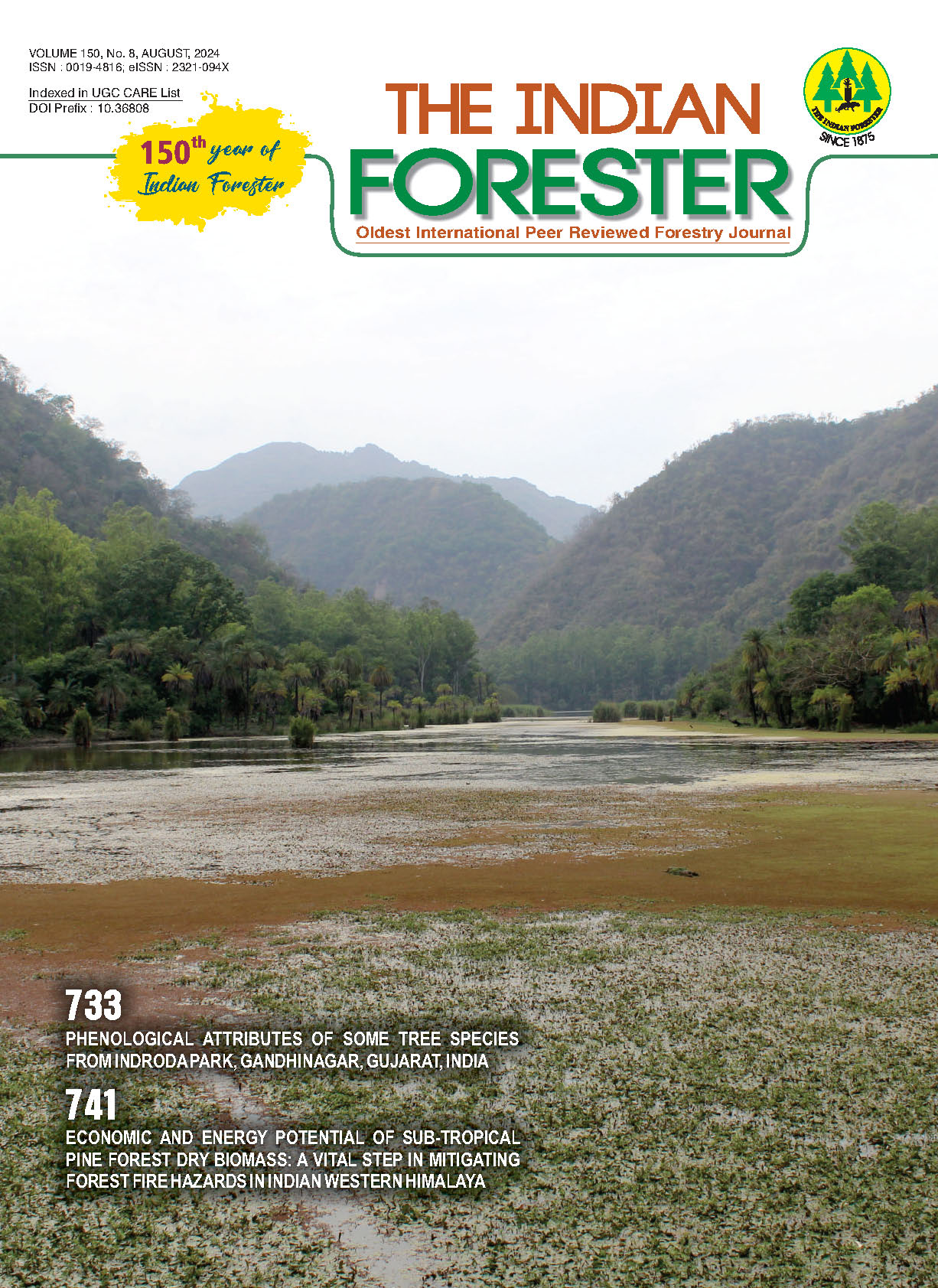Phenological Attributes of some Tree Species from Indroda Park, Gandhinagar, Gujarat, India
DOI:
https://doi.org/10.36808/if/2024/v150i8/170432Keywords:
Phenology, New Foliage, Leaf Fall, Flowering, Fruiting, Environmental Variables.Abstract
Phenological observations were carried out on twenty five woody tree species of fourteen different families in Indroda Nature Park, Gandhinagar in Gujarat state. Gandhinagar is positioned between 20°6' N to 24°42' N latitude and 68°10' E to 74°28' E longitude where twenty five selected tree species were tagged and observed twice in a month for consecutive three years from January 2019 to December 2021. Main four phenophages were observed i.e., new foliage, leaf fall, flowering and fruiting respectively. Percent species in phenophase and average number of approximate days were calculated for detailed study. Maximum new foliage was recorded in 22 species (2019), 16 species (2020 and 2021) respectively and found in August month. Maximum leaf fall was recorded in 15 species (2019), 16 species (2020 and 2021) respectively and found during January month. 17 species (2019), 19 species (2020 and 2021) showed flowering during month of April. In fruiting event, maximum fruiting in 22 species (2019 and 2021), 23 species (2020) was noted in May month. Average deviation in new foliage and leaf fall were ± 1.45 days and ± 4.61 days respectively. On the other hand, deviation in flowering was ± 5.42 days and in fruiting there was ± 6.82 days. Positive and negative correlation among different phenological traits and environmental parameters showed that there is significant association between tree phenology and existing environment. If any change occurs in environment, there will be its impact on phenological behavior. This type of research holds significant value in comprehending how plant species adapt, proving invaluable for fields like physiology, ecology and forestry.References
Borchert R., Meyer S.A., Felger R.S. and Porter-Bolland L. (2004). Environmental control of flowering periodicity in Costa Rican and Mexican tropical dry forests, Global Ecology and Biogeography, 13: 409-425.
Chapman C.A., Chapman L.J., Struhsaker T.T., Zanne A.E., Clark C.J. and Poulson J.R. (2005). A long-term evaluation of fruiting phenology: importance of climate change, Journal of Tropical Ecology, 21: 31–45.
Desai P.B. and Patel N.K. (2010). Phenological study of tree species of Satlasana range forest (North Gujarat), Life sciences Leaflets, 3: 41-46.
Frankie G.W., Baker H.G. and Opler P.A. (1974). Comparative phenological studies of trees in tropical wet and dry forests in the low lands of Costa Rica, Journal of Ecology, 62: 881-919.
Gohil K. (2005). Phenological studies of Reserve Forest (Victoria Park), near Bhavnagar. PhD Thesis, Bhavnagar University, Bhavnagar.
Kaur G., Singh, B. and Nagpal A. (2013). Phenology of some phanerogams of northwestern Punjab, India, Journal of Botany, 2013: 1-10.
Kasarkar A.R. and Kulkarni D.K. (2011). Phenological studies of family zingiberaceace with special reference to Alpina and Zingiber from Kolhapur region (MS) India, Bioscience Discovery, 2(3): 322-327.
Kumar V., Patel R., Singh S.K., Desai B.S. and Chourasia S. (2014). Studies on phenological characteristics of different forest trees of South Gujarat, India, Plant Archives, 14(2): 1015-1021.
Moza M.K. and Bhatnagar A.K. (2005). Phenology and climate change, Current Science, 9: 243-244.
Nakar R.N. and Jadeja B.A. (2009). Studies on morphology, ethnobotany and phenology of Prosopis in Girnar Forest, Junagadh, Gujarat. In Proceedings of National Symposium of Prosopis: Ecological, economic significance and management challenges. Gujarat Institute of Desert Ecology, Bhuj, pp: 51-53.
Nakar R.N. and Jadeja B.A. (2010). Phenological studies of some tree species from Girnar Reserve Forest, Gujarat, India, Plant Archivers, 10(2): 825-828.
Nakar R.N. (2013). Studies on phenological patterns of Girnar Reserve Forest, near Junagadh, Gujarat, PhD Thesis, Saurashtra University, Rajkot.
Nakar R.N., Jadeja B.A. and Dhaduk H.L. (2014). Phenological studies of two bombacacean members from girnar reserve forest, Junagadh, Gujarat, India, Indian forester, 140(1): 59-64.
Nakar R.N. and Jadeja B.A. (2015). Flowering and fruiting phenology of some herbs, shrubs and undershrubs from Girnar ReserveForest, Gujrat, India, Current Science, 108(1): 111-118.
Opler P.A., Frankie G.W. and Baker H.G. (1980). Comparative phenological studies of trees in tropical wet and dry forests in the low lands of Costa Rica, Journal of Ecology, 68: 167-188.
Rathore A. and Jasrai Y.T. (2014). Impact of climate change on the trees of Gujarat, India, National Journal of Fundamental and Applied Life Sciences, 4(4): 438-447.
Singh J.S. and Singh V.K. (1992). Phenology of seasonal dry tropical forest, Current Science, 63: 684-688.
Singh K.P. and Kushwaha C.P. (2006). Diversity of flowering and fruiting phenology of trees in a tropical deciduous forest in India, Annals of Botany, 97(2): 265-276.
Van Schaik C.P., Terborgh J.W. and Wright S.J. (1993). The phenology of tropical forests: adaptive significance and consequences for primary producers, Annual Review of Ecology and Systematics, 24: 353-377.
Walter H. (1971). Ecology of tropical and subtropical vegetation, 2nd edition, Oliver & Boyd, Edinburgh, 521+ pp.
Downloads
Downloads
Additional Files
Published
How to Cite
Issue
Section
License
Unless otherwise stated, copyright or similar rights in all materials presented on the site, including graphical images, are owned by Indian Forester.





